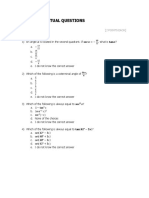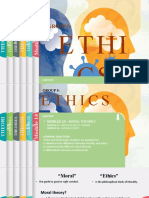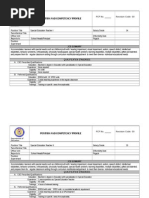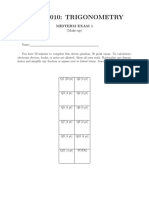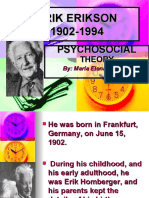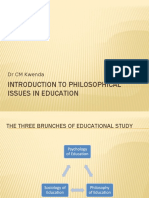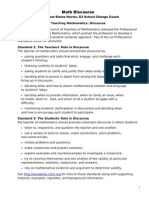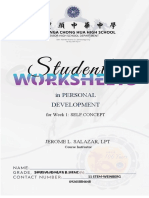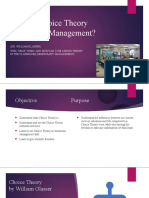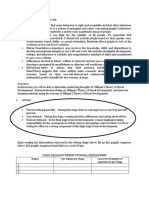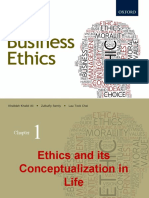0 ratings0% found this document useful (0 votes)
58 viewsMoral Dilemmas
Moral Dilemmas
Uploaded by
Abigail PanesThis document discusses different types of moral dilemmas. It defines a moral dilemma as a situation where a moral agent must choose between two or more conflicting options that are both morally unacceptable. The document outlines four main types of moral dilemmas: 1) epistemic and ontological dilemmas where there is a lack of knowledge or conflict between moral requirements, 2) self-imposed vs. world-imposed dilemmas caused by one's own actions or external events, 3) obligation vs. prohibition dilemmas involving choosing between two wrong options, and 4) single-agent vs. multi-person dilemmas that involve one or multiple moral agents. It also discusses moral dilemmas at the systemic, organizational, and individual levels.
Copyright:
© All Rights Reserved
Available Formats
Download as PPTX, PDF, TXT or read online from Scribd
Moral Dilemmas
Moral Dilemmas
Uploaded by
Abigail Panes0 ratings0% found this document useful (0 votes)
58 views16 pagesThis document discusses different types of moral dilemmas. It defines a moral dilemma as a situation where a moral agent must choose between two or more conflicting options that are both morally unacceptable. The document outlines four main types of moral dilemmas: 1) epistemic and ontological dilemmas where there is a lack of knowledge or conflict between moral requirements, 2) self-imposed vs. world-imposed dilemmas caused by one's own actions or external events, 3) obligation vs. prohibition dilemmas involving choosing between two wrong options, and 4) single-agent vs. multi-person dilemmas that involve one or multiple moral agents. It also discusses moral dilemmas at the systemic, organizational, and individual levels.
Original Description:
Ethics
Copyright
© © All Rights Reserved
Available Formats
PPTX, PDF, TXT or read online from Scribd
Share this document
Did you find this document useful?
Is this content inappropriate?
This document discusses different types of moral dilemmas. It defines a moral dilemma as a situation where a moral agent must choose between two or more conflicting options that are both morally unacceptable. The document outlines four main types of moral dilemmas: 1) epistemic and ontological dilemmas where there is a lack of knowledge or conflict between moral requirements, 2) self-imposed vs. world-imposed dilemmas caused by one's own actions or external events, 3) obligation vs. prohibition dilemmas involving choosing between two wrong options, and 4) single-agent vs. multi-person dilemmas that involve one or multiple moral agents. It also discusses moral dilemmas at the systemic, organizational, and individual levels.
Copyright:
© All Rights Reserved
Available Formats
Download as PPTX, PDF, TXT or read online from Scribd
Download as pptx, pdf, or txt
0 ratings0% found this document useful (0 votes)
58 views16 pagesMoral Dilemmas
Moral Dilemmas
Uploaded by
Abigail PanesThis document discusses different types of moral dilemmas. It defines a moral dilemma as a situation where a moral agent must choose between two or more conflicting options that are both morally unacceptable. The document outlines four main types of moral dilemmas: 1) epistemic and ontological dilemmas where there is a lack of knowledge or conflict between moral requirements, 2) self-imposed vs. world-imposed dilemmas caused by one's own actions or external events, 3) obligation vs. prohibition dilemmas involving choosing between two wrong options, and 4) single-agent vs. multi-person dilemmas that involve one or multiple moral agents. It also discusses moral dilemmas at the systemic, organizational, and individual levels.
Copyright:
© All Rights Reserved
Available Formats
Download as PPTX, PDF, TXT or read online from Scribd
Download as pptx, pdf, or txt
You are on page 1of 16
MORAL DILEMMAS
ETHICS (BSBA 1B)
LECTURE NO. 3
WHAT ARE MORAL DILEMMAS?
These are situations where persons, who are
called, “moral agents” in ethics, are forced to
choose between two or more conflicting options,
neither of which resolves the situation in a
morally acceptable manner.
TYPES OF MORAL
DILEMMAS
1. EPISTEMIC AND ONTOLOGICAL
DILEMMAS
EPISTEMIC MORAL DILEMMA
There are two or more moral requirements that
conflict with each other. The moral agent hardly
knows which one takes precedence over the other. One
option must be better than the other; only it needs
fuller knowledge of the situation.
1. EPISTEMIC AND ONTOLOGICAL
DILEMMAS
ONTOLOGICAL MORAL DILEMMA
There are two or more moral requirements that conflict with
each other, yet neither of these conflicting moral requirements
override each other. Neither of the moral requirements is
stronger than the other; hence, the moral agent can hardly
choose between the conflicting moral requirements.
2. SELF-IMPOSED AND WORLD-IMPOSED
DILEMMA
SELF-IMPOSED DILEMMA
A self-imposed dilemma is a situation that has been
caused by the individual’s mistakes or misconduct.
The moral dilemma is self-inflicted. This can cause a
number of complications when attempting to make a
decision.
2. SELF-IMPOSED AND WORLD-IMPOSED
DILEMMA
WORLD-IMPOSED DILEMMA
A world-imposed dilemma is a situation where events that
we can’t control have created an unavoidable moral conflict.
An individual must resolve a moral dilemma, even though
the cause of it is beyond his/her control. For example, this
could be in times of war or a financial crash.
3. OBLIGATION DILEMMAS AND
PROHIBITION DILEMMAS
Prohibition dilemmas are the opposite of obligation dilemmas.
The choices that are offered to us are all, on some level,
morally reprehensible.
They can all be considered as wrong, but we must choose one.
They could be illegal, or just plain immoral. An individual must
choose between what would normally be considered as
prohibited.
4. SINGLE-AGENT AND MULTI PERSON
DILEMMAS
SINGLE-AGENT MORAL DILEMMA
The agent “ought, all things considered, to do A,
ought all things considered, to do B, and she cannot
do both A and B”.
4. SINGLE-AGENT AND MULTI PERSON
DILEMMAS
MULTI-PERSON MORAL DILEMMA
One agent, P1, ought to do A, a second agent, P2, ought to
do B, and though each agent can do what he ought to do,
it is not possible both for P1 to do A and P2 to do B”. It
requires more than choosing what is right; it also entails
that the persons involved reached a general consensus.
TYPES OF MORAL
DILEMMAS
A. SYSTEMIC (MACRO-LEVEL)
Ethical Standards are universal or general;
ethical standards apply to all who are within the
system (Example: R.A 6713 “Code of Conduct
and Ethical Standards for Public Officials and
Employees)
B. ORGANIZATIONAL (COMPANY LEVEL)
At a company or corporate level, ethical standards
are embedded in the policies and procedures of the
organization; ethical standards apply to all those
within the organization (Example: code of Ethics
for Professional Teachers)
C. INDIVIDUAL (INDIVIDUAL LEVEL)
Ethical Standards of individuals; individuals may
well have a different set of ethical standards from
their employer (organization) and this can lead to
tensions.
ANY QUESTIONS?
THANK YOU!
You might also like
- The 7 - Step Moral ReasoningDocument11 pagesThe 7 - Step Moral ReasoningAbigail Panes75% (4)
- Moral DeliberationDocument15 pagesMoral DeliberationAbigail Panes100% (1)
- BMO2004 PRACTISE Assessment MCQ TEST SAMPLE Chapter 2 Normative Theory of EthcisDocument10 pagesBMO2004 PRACTISE Assessment MCQ TEST SAMPLE Chapter 2 Normative Theory of EthcisannesNo ratings yet
- Sped 3rd Observation Lesson PlanDocument2 pagesSped 3rd Observation Lesson Planapi-243298110No ratings yet
- Part 1. Conceptual Questions: Multiple ChoiceDocument9 pagesPart 1. Conceptual Questions: Multiple ChoiceRio Kyla Netzy BaclaanNo ratings yet
- Ethics Group 5Document32 pagesEthics Group 5Sylpauline Ebora100% (1)
- # Lecture 6 Revision LectureDocument27 pages# Lecture 6 Revision Lecturerahul thumar100% (1)
- Module 5 Filipino Culture and Morality, PDFDocument4 pagesModule 5 Filipino Culture and Morality, PDFrx78 gundamNo ratings yet
- Difficulty in Remembering and FocusingDocument9 pagesDifficulty in Remembering and FocusingKen Paul Balcueva100% (1)
- Institute of Education, Arts and Sciences First Semester, A.Y. 2020 - 2021 Outcomes - Based Teaching and Learning Plan in EthicsDocument16 pagesInstitute of Education, Arts and Sciences First Semester, A.Y. 2020 - 2021 Outcomes - Based Teaching and Learning Plan in EthicsEila Roshame Pineda100% (1)
- Ict and SpedDocument160 pagesIct and SpedQueen Anne Bobier - tomacderNo ratings yet
- ETHICSDocument4 pagesETHICSJeth Vigilla NangcaNo ratings yet
- Sped TeacherDocument8 pagesSped TeacherGirlie Harical GangawanNo ratings yet
- Universalism vs. Cultural RelativismDocument10 pagesUniversalism vs. Cultural Relativismkay parkerNo ratings yet
- Piaget and MontessoriDocument2 pagesPiaget and MontessoriDeborah Jiménez100% (1)
- Realism: Philosophical Perspectives of EducationDocument24 pagesRealism: Philosophical Perspectives of Educationetthar100% (1)
- Lesson Plan For Sped 311 Animal CellDocument4 pagesLesson Plan For Sped 311 Animal Cellapi-302696757No ratings yet
- Bse Major in MathematicsDocument7 pagesBse Major in MathematicsMac Jayvin Suetos BalanayNo ratings yet
- Math 1010: Trigonometry: Midterm Exam 1 (Make-Up)Document7 pagesMath 1010: Trigonometry: Midterm Exam 1 (Make-Up)RajNo ratings yet
- Erik Erikson - Powerpoint .Educ 22Document47 pagesErik Erikson - Powerpoint .Educ 22gwendarleneNo ratings yet
- Calculus RelatedRates ProblemWithSolutionsDocument32 pagesCalculus RelatedRates ProblemWithSolutionsEdrian A. MañalongNo ratings yet
- Local Media4116055460931556364Document35 pagesLocal Media4116055460931556364joy panganibanNo ratings yet
- PGCE Introduction To PhilosophyDocument15 pagesPGCE Introduction To PhilosophySiphumeze Titi100% (1)
- Math Best PracticesDocument5 pagesMath Best Practicesmcuzsay_92No ratings yet
- Understanding The Self - Spiritual SelfDocument14 pagesUnderstanding The Self - Spiritual SelfJoyce-an DibdibNo ratings yet
- EED 001 - 2 Approaches To Values EdDocument23 pagesEED 001 - 2 Approaches To Values EdDeryl FalconNo ratings yet
- Syllabus in Ethics - BSED AY 2020-2021 20-2Document11 pagesSyllabus in Ethics - BSED AY 2020-2021 20-2Xeline Mae IdealNo ratings yet
- Nine Steps To More Effective Parenting: 1. Boosting Your Child's Self-EsteemDocument3 pagesNine Steps To More Effective Parenting: 1. Boosting Your Child's Self-Esteemapi-522213725No ratings yet
- ConstructivismDocument24 pagesConstructivismgiancarloguiananislerNo ratings yet
- Maricris L. Llano: SPED 608Document4 pagesMaricris L. Llano: SPED 608MARICRIS LLANONo ratings yet
- Level of Achievement of Course and Program Learning OutcomesDocument15 pagesLevel of Achievement of Course and Program Learning OutcomesCATHLYN MAE FLORESNo ratings yet
- Calculus 2 Final Exam PDFDocument46 pagesCalculus 2 Final Exam PDFazs88.bscpe.amauniversityNo ratings yet
- Elements of Visual ArtsDocument60 pagesElements of Visual ArtsWinterMae BacalsoNo ratings yet
- Perdev Worksheet ArajiDocument11 pagesPerdev Worksheet ArajiNurhaliza KuhutanNo ratings yet
- Topic 3 Guidance and CounselingDocument26 pagesTopic 3 Guidance and Counselingreymark estopa100% (1)
- Madrasah PDFDocument11 pagesMadrasah PDFAizer LorenaNo ratings yet
- KFCDocument20 pagesKFCjunaidchaudaryNo ratings yet
- ETHICSDocument34 pagesETHICSjhell dela cruzNo ratings yet
- MATRIX OF DANICA - DRRM ComponentsDocument5 pagesMATRIX OF DANICA - DRRM ComponentsMarco Ceazar VeronaNo ratings yet
- Self Determination Lesson Plan and ReflectionDocument7 pagesSelf Determination Lesson Plan and ReflectionDanielle ChemelloNo ratings yet
- Slide 1 Philosophy and BranchesDocument30 pagesSlide 1 Philosophy and BranchesMimie Sulaiman100% (1)
- General Mathematics Final OutputDocument3 pagesGeneral Mathematics Final OutputMelcah meroy logagayNo ratings yet
- Erikson's Psychosocial DevelopmentDocument5 pagesErikson's Psychosocial DevelopmentMarina Charlotte FournesNo ratings yet
- Module 3 Math LanguageDocument6 pagesModule 3 Math LanguageONDONG, Zsarnainne P.No ratings yet
- Module 1 General Introduction What Is EthicsDocument23 pagesModule 1 General Introduction What Is EthicsNyssa G100% (1)
- Module 3 - Problem Solving and ReasoningDocument4 pagesModule 3 - Problem Solving and ReasoningJala, Jan Kylle B.No ratings yet
- Art AppreciationDocument86 pagesArt AppreciationMelessa FernandezNo ratings yet
- Midterm ExamDocument5 pagesMidterm ExamRonelle San buenaventuraNo ratings yet
- Rubrics For Attitude Towards LearningDocument1 pageRubrics For Attitude Towards Learningmmhoward20100% (1)
- Group 11-AdolescentDocument23 pagesGroup 11-AdolescentjellibethremortaNo ratings yet
- Developmental Theories and Other Relevant TheoriesDocument12 pagesDevelopmental Theories and Other Relevant TheoriesCristy Quirong SorialNo ratings yet
- Solo TaxonomyDocument7 pagesSolo TaxonomyMark Delos ReyesNo ratings yet
- Marzano and Kendall 2007 TaxonomyDocument1 pageMarzano and Kendall 2007 TaxonomyFactoran Wilfred100% (1)
- Principles and Elements of DesignsDocument37 pagesPrinciples and Elements of DesignsAivan CañeteNo ratings yet
- Tet Aptitude Test Question PaperDocument4 pagesTet Aptitude Test Question PaperJinu MadhavanNo ratings yet
- Directing Change Suicide Prevention Lesson PlanDocument23 pagesDirecting Change Suicide Prevention Lesson PlanVanessa Devota Veloso - RamirezNo ratings yet
- Teaching Social StudiesDocument15 pagesTeaching Social Studieszherlyn amilasan100% (2)
- Unit 3 - Ethics - Part 2 - The Human ActDocument23 pagesUnit 3 - Ethics - Part 2 - The Human ActErica Caturay100% (1)
- Creating A Positive School CultureDocument18 pagesCreating A Positive School CultureGlezyl U SepaganNo ratings yet
- Choice Theory Classroom ManagementDocument9 pagesChoice Theory Classroom Managementapi-584426874No ratings yet
- Educational Leadership: a Student-Centered ApproachFrom EverandEducational Leadership: a Student-Centered ApproachNo ratings yet
- Moral DilemmasDocument16 pagesMoral Dilemmasabby panesNo ratings yet
- School As A Cultural InstitutionDocument36 pagesSchool As A Cultural InstitutionAbigail PanesNo ratings yet
- Purposive Communication Lecture #4Document18 pagesPurposive Communication Lecture #4Abigail PanesNo ratings yet
- The Strengths and Weaknesses of The Filipino CharacterDocument20 pagesThe Strengths and Weaknesses of The Filipino CharacterAbigail Panes100% (1)
- The History of Philippine Education System Lecture No. 4Document46 pagesThe History of Philippine Education System Lecture No. 4Abigail PanesNo ratings yet
- The Moral Act Lecture No. 6Document26 pagesThe Moral Act Lecture No. 6Abigail PanesNo ratings yet
- The 1987 Philippine Constitution NSTP Lecture No. 2Document29 pagesThe 1987 Philippine Constitution NSTP Lecture No. 2Abigail PanesNo ratings yet
- The Teacher and The Community Lecture #1Document14 pagesThe Teacher and The Community Lecture #1Abigail Panes100% (1)
- Historical Foundation of Education Lecture No. 2Document29 pagesHistorical Foundation of Education Lecture No. 2Abigail PanesNo ratings yet
- Civic Welfare Training Service Lecture No. 1Document22 pagesCivic Welfare Training Service Lecture No. 1Abigail PanesNo ratings yet
- Ethics in Communication Lecture 3Document34 pagesEthics in Communication Lecture 3Abigail PanesNo ratings yet
- Foundation of Morality Lecture 4Document21 pagesFoundation of Morality Lecture 4Abigail PanesNo ratings yet
- Concepcion Holy Cross College, Inc. Barangay Minane, Concepcion, TarlacDocument3 pagesConcepcion Holy Cross College, Inc. Barangay Minane, Concepcion, TarlacAbigail PanesNo ratings yet
- Concepcion Holy Cross College, Inc. Barangay Minane, Concepcion, TarlacDocument2 pagesConcepcion Holy Cross College, Inc. Barangay Minane, Concepcion, TarlacAbigail PanesNo ratings yet
- Curriculum Map - Arts 8Document5 pagesCurriculum Map - Arts 8Abigail PanesNo ratings yet
- Article III - Bill of RightsDocument37 pagesArticle III - Bill of RightsAbigail PanesNo ratings yet
- Curriculum Map - Computer 10Document2 pagesCurriculum Map - Computer 10Abigail PanesNo ratings yet
- Good Citizenship ValuesDocument35 pagesGood Citizenship ValuesAbigail PanesNo ratings yet
- Curriculum Map - Science 9Document5 pagesCurriculum Map - Science 9Abigail PanesNo ratings yet
- Concepcion Holy Cross College, Inc. Barangay Minane, Concepcion, TarlacDocument3 pagesConcepcion Holy Cross College, Inc. Barangay Minane, Concepcion, TarlacAbigail PanesNo ratings yet
- Curriculum Map - English 7Document13 pagesCurriculum Map - English 7Abigail PanesNo ratings yet
- Curriculum Map - Mathematics 7Document3 pagesCurriculum Map - Mathematics 7Abigail PanesNo ratings yet
- Seven Capital Sins Opposite Corresponding Virtues and ExtremesDocument1 pageSeven Capital Sins Opposite Corresponding Virtues and ExtremesDenis Alibor MajhenNo ratings yet
- Ethics Business Ethics Lec1Document28 pagesEthics Business Ethics Lec1Rajesh PatilNo ratings yet
- Kelsen's Imperative Theory of Law PresentationDocument13 pagesKelsen's Imperative Theory of Law PresentationKaran KanjwaniNo ratings yet
- Berker - The Explanatory Ambitions of Moral Principles (2019)Document33 pagesBerker - The Explanatory Ambitions of Moral Principles (2019)Luigi LucheniNo ratings yet
- The AFP Core of ValuesDocument2 pagesThe AFP Core of ValuesРон ГалNo ratings yet
- The Twelve Lasallian VirtuesDocument7 pagesThe Twelve Lasallian VirtuesAndrei AlcantaraNo ratings yet
- 04 Task Performance Material 1Document4 pages04 Task Performance Material 1Cliezl Bautista NguhoNo ratings yet
- Module 3 - The Nature of Work EthicsDocument10 pagesModule 3 - The Nature of Work EthicsMaria Jasmin LoyolaNo ratings yet
- Chapter 2 - Defining Business EthicsDocument20 pagesChapter 2 - Defining Business EthicsLena KhalidNo ratings yet
- The Human Acts and Christian Faith (Autosaved)Document16 pagesThe Human Acts and Christian Faith (Autosaved)Gemard JemNo ratings yet
- Kohlberg'S Theory of Moral DevelopmentDocument12 pagesKohlberg'S Theory of Moral DevelopmentDairane CastañedaNo ratings yet
- Foundation Principles of EthicsDocument5 pagesFoundation Principles of EthicsAldamar, Aiza Mae C.No ratings yet
- Lectures 3 & 4Document20 pagesLectures 3 & 4Ali Arsal KhanNo ratings yet
- 2m Ethics and Values SystemDocument3 pages2m Ethics and Values SystemPearl Aubrey LealNo ratings yet
- Business EthicsDocument4 pagesBusiness EthicsJhester Angelo P GuerraNo ratings yet
- Image 00031Document10 pagesImage 00031Siddharth VermaNo ratings yet
- Business Ethics Is InevitableDocument39 pagesBusiness Ethics Is InevitableAdrian AbonNo ratings yet
- Project Fec27 (Bhuvansh Behal and Ayush Srivastava)Document22 pagesProject Fec27 (Bhuvansh Behal and Ayush Srivastava)Ayush SinghNo ratings yet
- Virtue Ethics and The Natural Law EthicsDocument16 pagesVirtue Ethics and The Natural Law EthicsDaniel Redd Rele�asNo ratings yet
- Polytechnic University of The Philippines Midtern Exam EthicsDocument2 pagesPolytechnic University of The Philippines Midtern Exam EthicsJo-annNo ratings yet
- CFLM 2Document9 pagesCFLM 2Abegail GerobinNo ratings yet
- Case Study Analysis Assignment #7 Case No 13.1 Choosing A Research AssistantDocument4 pagesCase Study Analysis Assignment #7 Case No 13.1 Choosing A Research Assistantsagar patelNo ratings yet
- Reviewer On CleDocument4 pagesReviewer On CleTodo RokiNo ratings yet
- Ethical Considerations Moral Issues Legal Issues and Concerns of EuthanasiaDocument2 pagesEthical Considerations Moral Issues Legal Issues and Concerns of EuthanasiaAntonette BasilioNo ratings yet
- Module 3 - The ActDocument7 pagesModule 3 - The ActAlleah Jayzel GarciaNo ratings yet
- Gilligan's Theory of Moral DevelopmentDocument3 pagesGilligan's Theory of Moral DevelopmentJustine ArisgaNo ratings yet
- Unit I Human Values SYLLABUS: Morals, Values and Ethics - Integrity - Work Ethic - Service Learning - Civic VirtueDocument21 pagesUnit I Human Values SYLLABUS: Morals, Values and Ethics - Integrity - Work Ethic - Service Learning - Civic VirtueJohn andre MarianoNo ratings yet
- Chapter 1Document29 pagesChapter 1Hidayah AzmanNo ratings yet
- Ge Ethics Lesson 1 Ethics As A Science of MoralityDocument42 pagesGe Ethics Lesson 1 Ethics As A Science of MoralityLovely Quevedo ʚĩɞNo ratings yet





